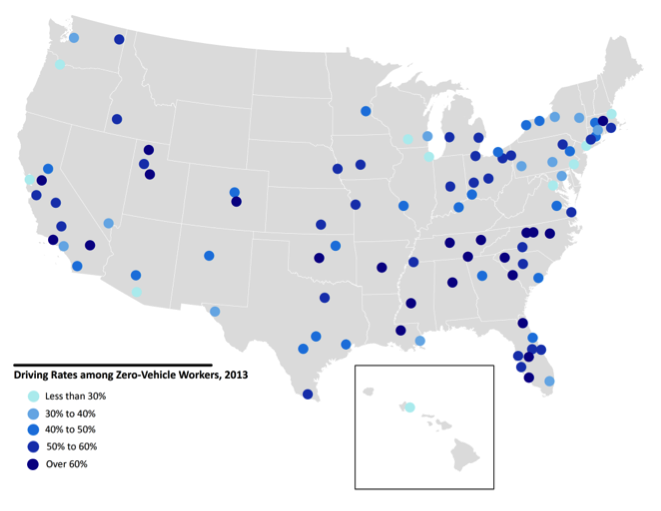
Cross-posted from Brookings’ The Avenue blog. This article is the second in a short series examining new Census data on transportation trends.
While more Americans are relying on alternative modes to get to work every day, cars still define most of our commutes. Over time, these high driving rates not only reflect a built environment that continues to promote vehicle usage — despite recent shifts toward city living and job clustering — but also call into question how well our transportation networks offer access to economic opportunity for all workers.
This is especially important for those workers without cars.
The most recent 2013 Census numbers shed light on the commuting habits of the 6.3 million workers who don’t have a private vehicle at home. That’s about 4.5 percent of all workers, up from 4.2 percent in 2007.
Zero-vehicle workers still do quite a bit of driving. Over 20 percent drive alone to work — meaning they find a private car to borrow — and another 12 percent commute via carpool. Both rates jumped between 2007 and 2013, defying national trends toward less driving. This paints a discouraging picture about transportation access across the country for a segment of commuters who must expend extra effort to get to work.
Metropolitan data underscores the breadth of this problem. Transit-rich metros like New York, San Francisco, and Chicago have the most zero-vehicle workers, and they drive less frequently. However, in other large metro areas like Dallas, Detroit, and Riverside, over half the zero-vehicle workers find a car to drive to work. Driving rates jump to over 70 percent in metros like Birmingham, AL; Jackson, MS; and Provo, UT. Across 77 of the 100 largest metro areas, at least 40 percent of zero-vehicle commuters drive to work.
These commuting habits confirm prior research. Our work has found that nearly all zero-vehicle households live in neighborhoods with transit service, but those routes only connect them to 40 percent of jobs within 90 minutes. And the Urban Institute found vehicle availability can improve economic outcomes for housing voucher recipients, especially in terms of neighborhood choice. It’s little wonder that many car-less commuters find a vehicle to get to work.
Policymakers at all government levels must improve access to jobs for all workers and across all transportation modes.
With many workers facing limited job access without cars, it’s clear why the automobile is still the mode of choice. Andrew Owen and David Levinson’s recent automobile and transit models verify it. Maps from MIT’s You Are Here show the car winning on long city commutes; imagine if those maps spread through the whole metro area. But these advantages also push households to take on the added expense of vehicle ownership, an especially large burden for lower-income households.
To address this inequity, we need to shift how we plan transportation investments and urban development. Planners and engineers need to think less about the speed of our travel and more about access — how many destinations we can reach. Grounded in the daily experience of commuters, this perspective can help meet the needs of workers and employers, better tying together regional economies.
An accessibility approach can be particularly helpful in promoting more concentrated development — including job locations — and shortening trip distances. Those patterns would incentivize walking and bicycling, with all of their related benefits, and even address transit’s longer commute times. Some workers may be able to stay productive during transit trips, but those long trips aren’t especially productive for people in certain occupations (like retail, for example) and for those who don’t own a web-connected device. This approach can also grow the burgeoning ride-sharing industry, for commutes and other trips.
Throughout our 2013 Census analyses, we found transportation choices are changing. But more work needs to be done to build healthier regional economies, and that work begins with delivering a transportation system that offers choice and expands access.
Adie Tomer and Joseph Kane are researchers at the Brookings Metropolitan Policy Program in Washington, DC.





